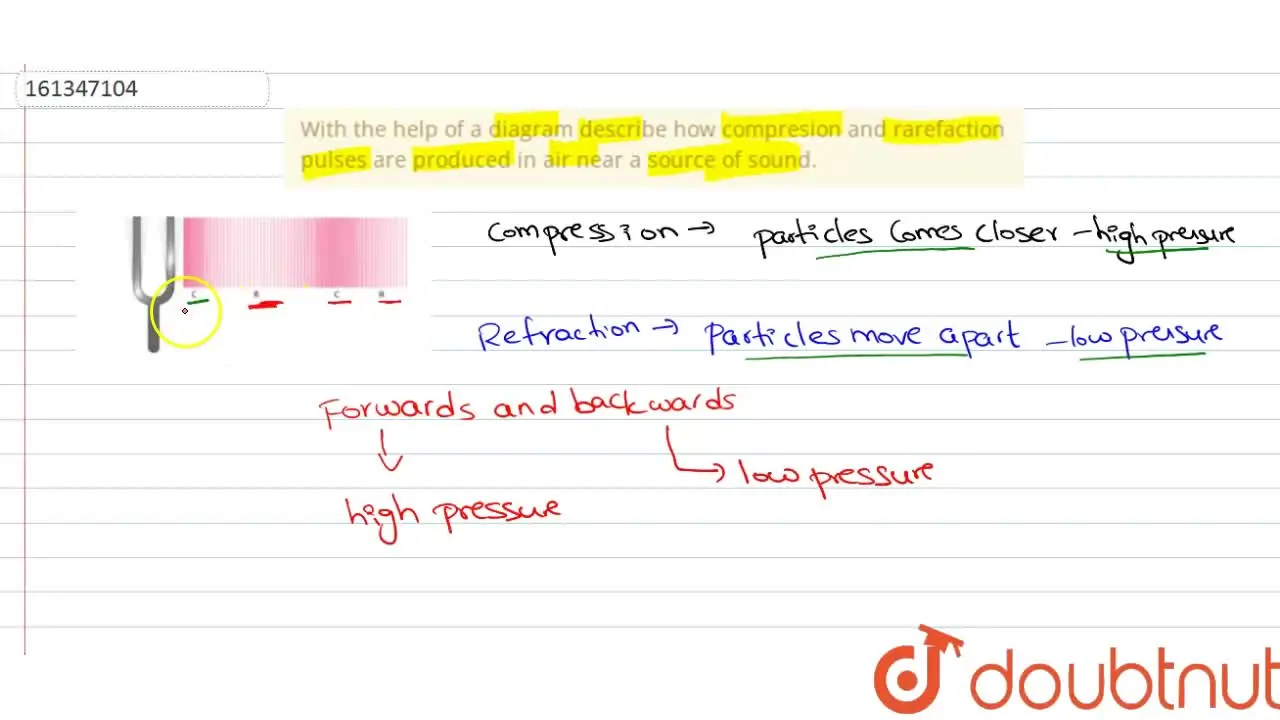With the help of a diagram describe how compresion and rarefaction pulses are produced in air near a source of sound.Solution in Telugu
1) Consider a vibrating membrane of a musical instrumentlike a drum or tabla.
2) As it moves back and forth, it produces a sound.
3) The figure shows the membrane at different instants and the condition of the air near it at those instants.
4) As the membrane moves forward, it pushes the particles of air in the layer in front of it.
5) So, the particles of air in the layer get closer to each other, hence the density increases.
6) This layer of air pushes and compresses the layer next to it and so on.
7) We call this disturbance as compression pulse.
8) When the membrane moves backward, it drags back the layer of air near it. Hence the density decreases.
9) The particles of air in the next layer on the right move into fill this less dense area.
10) This is a rarefaction pulse moves to right.
11) As the membrae moves back and forth repeatedly, compression and rarefaction pulses are produced, one after the other.
12) These two pulses travel one behind the other, carrying the disturbance with it.
 .
.
Related Playlists
- BOOK - VGS PUBLICATION-BRILLIANTCHAPTER - SOUNDEXERCISE - TRY THESE7videos
SOUND
- BOOK - VGS PUBLICATION-BRILLIANTCHAPTER - SOUNDEXERCISE - ACTIVITIES5videos
SOUND
- BOOK - VGS PUBLICATION-BRILLIANTCHAPTER - SOUNDEXERCISE - ASKING QUESTIONS AND MAKING HYPOTHESIS1videos
SOUND
- BOOK - VGS PUBLICATION-BRILLIANTCHAPTER - REFLECTION OF LIGHT AT CURVED SURFACESEXERCISE - EXERCISE66videos
REFLECTION OF LIGHT AT CURVED SURFACES
- BOOK - VGS PUBLICATION-BRILLIANTCHAPTER - SYSTEM OF PARTICLES AND ROTATIONAL MOTION EXERCISE - PROBLEMS17videos
SYSTEM OF PARTICLES AND ROTATIONAL MOTION
Similar Questions
What do you understand by a sound wave ?
02:26View SolutionHow can you say that the sound is a form of energy?
02:00View SolutionYou might have observed that sometimes your pet dog starts barking though no one is seen in its surroundings or no disturbance heard nearby. Does this observation raise any doubts in your mind about the peculiar behaviour of dong after your understanding about 'range' of hearing the sound'. If yes, write them.
07:55View SolutionIs the image formed by a bulged surface same as the image formed by a plane mirror ?
04:16View SolutionShow that a.(b×c) is equal in magnitude to the volume of the parallelopiped formed on the three vectors a, b and c.
03:45View SolutionDescribe with the help of a diagram, how compressions and rarefactions are produced in air near a source of sound.
View SolutionHow are compressions and rarefactions produced near a source of sound ?
View Solution(a) How is sound produced? Explain with the help of an example. (b) How does sound from a sound producing body travel through air to reach our ears? Illustrate your answer with the help of a labelled diagram.
02:46View Solutionएक चित्र की सहायता से वर्णन कीजिए की ध्वनि के स्त्रोत के निकट वायु में सम्पीडन तथा विरलन कैसे उत्पन्न होते हैं?
01:13View SolutionDescribe with the help of a diagram , how compressions and rarefactions are produced m air near a source of sound.
03:34View SolutionDescribe with the help of a diagram, how compression and rarefractions are produced in air near a source of sound.
02:12View SolutionDescribe with the help of a diagram , how compression and rarefractions are produced in air near a source of sound
02:14View SolutionDescribe with diagram, how compressions and rarefactions are produced.
04:34View SolutionWith the help of a diagram describe how compression and rarefaction pulses are produced in air near a source of sound. (AS5)
01:13View SolutionDescribe with the help of a diagram, how compressions and rarefactions are produced in air near a source of sound.
02:12View Solution


